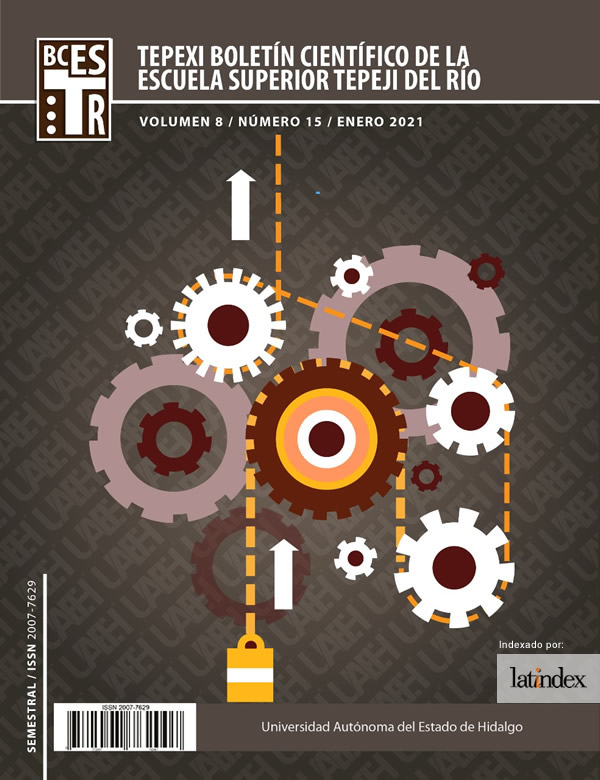Synthesis of ZnO nanoflakes using the ultrasonic spray pyrolisis technique
Abstract
In present work we report the fabrication of zinc oxide (ZnO) nanoflakes on glass substrates using the ultrasonic chemical spray technique. The fabrication of nanoflakes consisted of depositing ZnO at 260°C for 10 minutes using the chemical spray technique by nebulization and its subsequent heat treatment at 400°C during 30 minutes. The optical, morphological and structural properties were analyzed by UV-visible spectrometry, scanning electron microscopy (SEM) and X-ray diffraction (XRD). The study of the properties of the ZnO deposited in glass corroborated the presence and formation of homogeneously interconnected ZnO nanoflakes in sizes of approximately 35 nm (thickness) and 240-350 nm (length).
Downloads
References
M. S. Wagh, G.H. Jain, D.R. Patil, S.A. Patil, L.A. Patil (2006), “Modified Zinc Oxide thick film resisters as NH3 gas sensor”. Sensors and Actuators B: Chemical 115 (1) 128-133. https://doi.org/10.1016/j.snb.2005.08.030
Hendrik Swart (2019), “ZnO thin films for solar cell and lighting applications (Conference Presentation)”, Proc. SPIE 10919, Oxide-based Materials and Devices X, 109192E (8). https://doi.org/10.1117/12.2518227
Jun Sung Jang, Jihun Kim, Uma Ghorpade, Hyeong Ho Shin, Myeng Gil Gang, Sang Deok Park, Hyeong-Jin Kim, Dong Seon Lee, Jin Hyeok Kim (2019), “Comparison study of ZnO-based quaternary TCO materials for photovoltaic application”, Journal of Alloys and Compounds, 793, 499-504. https://doi.org/10.1016/j.jallcom.2019.04.042
Luis Castañeda (2011), “Present Status of the Develoment and Application of Transparent Conductors Oxide Thin Solid Films”, Materials Sciences and Applications, 2 (9), 1233-1242. https://doi.org/10.4236/msa.2011.29167
T.V.K. Karthik, A.G. Hernández, Yu. Kudriavtsev, H. Gómez-Pozos, M. G. Ramírez-Cruz, L. Martínez Ayala, A. Escobosa-Echvarria, (2020) “Sprayed ZnO thin films for gas sensing: effect of substrate temperatura, molarity and precursor solution”, Journal of Materials Science: Materials in Electronics, 31, 7470-7480. https://doi.org/10.1007/s10854-020-02987-7
Shrikant Saini, Paolo Mele, Takafumi Oyake, Junichiro Shiomi, Janne-Petteri Niemela, Maarit Karppinen, Koji Miyazaki, Chaoyang Li, Toshiyuki Kawaharamura, Ataru Ichinose, Leopoldo Molina-Luna, (2019), “Porosity.tuned therman conductinity in thermoelectric Al-doped ZnO thin films grown by mist-chemical vapor deposition”, Thin Solid Films, 685, 180-185. https://doi.org/10.1016/j.tsf.2019.06.010
O. Tigli and J. Juhala, (2011) "ZnO nanowire growth by physical vapor deposition," 11th IEEE International Conference on Nanotechnology, Portland, OR, 608-611. https://doi.org/10.1109/NANO.2011.6144585
M.R. Alfaro Cruz, O. Ceballos-Sanchez, E. Luévano-Hipólito, L.M. Torres-Martínez (2018), “ZnO thin films deposited by RF magnetron sputtering: Effects of the annealing and atmosphere conditions on the photocatalytic hydrogen production”, International Journal of Hydrogen Energy, 43 (22), 10301-10310. https://doi.org/10.1016/j.ijhydene.2018.04.054.
Nilam B. Patil, Amol R. Nimbalkar, Maruti G. Patil, (2018), “ZnO thin film prepared by a sol-gel spin coating technique for NO2 detection”, Materials Science and Engineering: B, 227, 53-60. https://doi.org/10.1016/j.mseb.2017.10.011.
Chin Boon Ong, Law Yong Ng, Abdul Wahab Mohammad, (2018), “A review of ZnO nanoparticles as solar photocatalysts: Synthesis, mechanisms and applications”, Renewable and Sustainable Energy Reviews, 81(1), 536-551. https://doi.org/10.1016/j.rser.2017.08.020.
Xiangxiang Chen, Yanbai Shen, Pengfei Zhou, Sikai Zhao, Xiangxi Zhong, Tingting Li, Cong Han, Dezhou Wei, Dan Meng (2019), “NO2 sensing properties of one-pot-synthesized ZnO nanowires with Pd functionalization”, Sensors and Actuators B: Chemical, 208, 151-161. https://doi.org/10.1016/j.snb.2018.10.063.
Yang Song, Fang Chen, Yueying Zhang, Sumei Zhang, Fangmeng Liu, Peng Sun, Xu Yan, Geyu Lu (2019), “Fabrication of highly sensitive and selective room-temperature nitrogen dioxide sensors based on the ZnO nanoflowers”, Sensors and Actuators B: Chemical, 287, 191-198. https://doi.org/10.1016/j.snb.2019.01.146.
T.V.K. Karthik, Ivan R. Vargas, A.G. Hernández, L. Martínez, H. Molina Ruiz (2019) “Diseño y fabricación del equipo de rocío químico asistido por ultra sonicación”, TEPEXI Boletín Científico de la Escuela Superior Tepeji del Río, 12, 14-19. https://doi.org/10.29057/estr.v6i12.4285
N. Lehraki, M.S. Aida, S. Abed, N. Attaf, A. Attaf, M. Poulain, Curr. (2012) “ZnO thin films deposition by spray pirolisis: Influence of precursor solution properties”, Current Applied Physics, 12 (5), 1283-1287. https://doi.org/10.1016/j.cap.2012.03.012












